We passed through lush fields as we drove down from Anegundi. There were neither huts nor shops in sight. All that we could see were columns of boulders randomly stacked on top of each other. Our auto stopped in front of some paddy fields as my guide Virupaksha announced our destination. “ Onake Kindi – This is a prehistoric site madam .”
The sun’s rays beat down rather mercilessly as we crossed the fields and climbed our way through a steep narrow pathway in a rocky terrain. The path led us to a wide plateau of tall grass , where we found ourselves ringed in by hillocks. There was no one in sight. “Keep a watch for snakes,“ came a word of caution, as we wondered where we had landed.
The idea of heading to Onake Kindi came up when I asked Virupaksha about megalithic dolmens in a site called Mourya Mane . I learnt that it was much further and high up in the hills and Virupaksha convinced me that he would instead take me to a prehistoric site closer to Anegundi, which had some rock paintings.
As we walked through the grass and looked around the boulders, we found a rock with some red and white markings, which had some stick figures of humans and some animals like the bull. In another boulder was a circular diagram which looked like drawings of sun and moon, but we could not figure out the symbolism behind it.
On my return to Bangalore, I started researching on the prehistoric sites near Anegundi and learnt from Professor Ravi Korisettar , an authority on the subject that the rock painting belonged to the Iron Age, somewhere around the period of about 1500 BC .
(PIC : Aarti K)
“The faded circular painting is a very rare depiction of a megalithic style of burial. If you look closely, you can see a human body in the middle and a lot of burial goods, surrounded by a stone circle“ said Professor Korisettar , from the Department of History and Archaeology from Karnatak University in Dharwad.
The sun and moon like symbols , the ladder and the water depicted on the rock probably referred to their various beliefs .” We can only interpret these images; the sun and moon for instance can be seen in some hero stones as well which probably suggests immortality,” added Prof Srikumar Menon, a Faculty of Architecture from the Manipal Institute of Technology.
You will find the bull in almost all paintings . It is a reference to the bull cult, which was a male fertility symbol, “ explained Professor Korisettar , talking about the symbolism in rock art.
I had not understood the significance of the paintings when I had seen those crude red sketches on the rocks. However as I delved deeper into it, I realized that we were probably looking at some of the most ancient forms of beliefs that are rather deep rooted within us today.
This story was published in the Metro Plus today in my column, Inside Story . I thank Professors Ravi KoriSettar and Srikumar Menon for sharing a lot of insights with me and Santosh Martin for putting me on to them. Its amazing to see how every corner of our country is so rich and it makes travel a wonderful experience for a simple vagabond like me .

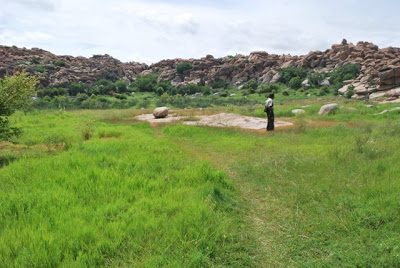

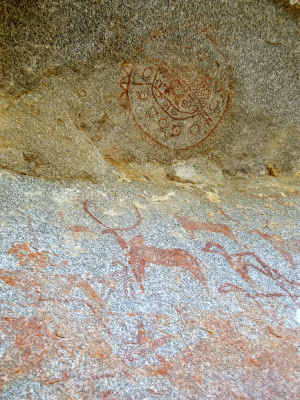
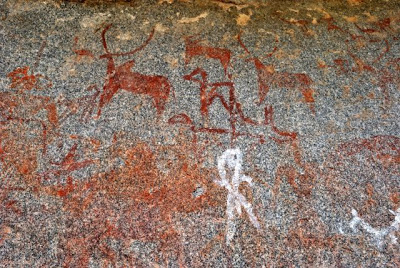
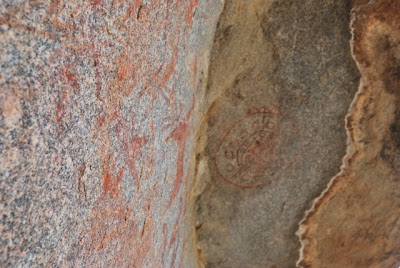
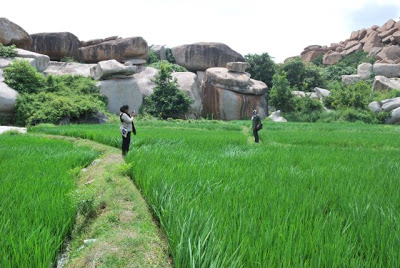
Wow…beautiful post. Thank you for writing on this.
love yr blog!
Interesting explanation on the prehistoric paintings. I have seen very similar pre-historic paintings at Bheem Betika in Madhya Pradesh.
This is wonderful!! lets hope i get to see them too when i am there!
This is fascinating. I had no idea about this.
It is really interesting…
nice. Shall visit some day.
superb.
The actual stone circle
http://www.poetryinstone.in/lang/en/2010/03/05/where-it-all-began-in-south-india-stone-circles.html
rgds
vj
Yes I read it in metro plus today. Congrats for the research. I have a list of other such site in bellary district. Hope to visit all these some time. The paintings were beautifully captured. looks so fresh
thanks for sharing this story with us. Fascinating to know how remains of the cultures have common threads with our present. I also applaud your efforts in delving deeper and bringing forth the historic importance of these paintings.
Wow! It’s a awesome post that i have ever seen in my life. Thanks for sharing this…I will also recommend this to my friends..
Luxury Safaris
Great post. If you are really interested, come to Bhopal and visit Bhimbetka as also other sites around Bhopal for the richest pre-historic rock paintings.
may i know the phone number or any details about that guide? Iam planning to go there in 2 weeks, Any pointers will help 🙂
Thanks for sharing this research Lakshmi! Great piece of backpacker historic journalism shall we say?
Thanks folks
The paintings are really beautiful. Thanks Lakshmi for sharing such an incredible part of India with us.
I Congradulate the research done by the scholar